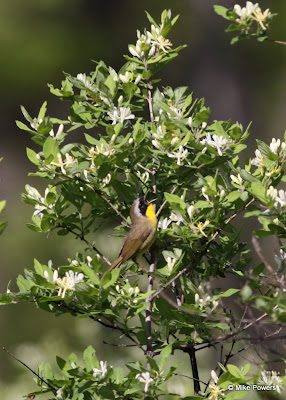Nate commented on the repeated up-and-down pattern, which translates to notes that are rising and falling. During June we have a few birds whose song fits the rising-falling pattern, but only one who matches the fluidity of this song. Have a listen to the video below to hear the actual song. Easier to identify this way, yes?
Click to play - you may need to turn up the volume
as I lost sound quality while making the video.
Congratulations go to Nate for correctly identifying the songster as a Common Yellowthroat. I hoped some guesses would come in for American Robin, Red-eyed or Warbling Vireo, possibly Scarlet Tanager, all species plausible in our yard that have an element of rising-and-falling songs. Three of those species could be eliminated by the continuous nature of the song: American Robin, Red-eyed Vireo, and Scarlet Tanager would all have pauses between phrases, which would show up as breaks of silence between the elements of the song.
 In addition to being a lower frequency, this image of an
In addition to being a lower frequency, this image of anAmerican Robin song shows clear breaks between the phrases.
Warbling Vireos sing a continuous song, but it is much buzzier than a Common Yellowthroat's song. This would be shown by heavily modulated notes on the spectrogram, while the yellowthroat's song is characterized by smooth, pure notes rising and falling.
Now I know two things: the new recording units are working out pretty well, and you have to get up earlier than a yellowthroat to put one over on Nate. I'll come up with a harder one next time!
Common Yellowthroat and American Robin recorded 07 Jun 2009 in Horseheads, NY.
Common Yellowthroat photographed May 2009, Spencer Crest Nature Center, Corning, NY.
-
Common Yellowthroat and American Robin recorded 07 Jun 2009 in Horseheads, NY.
Common Yellowthroat photographed May 2009, Spencer Crest Nature Center, Corning, NY.
-





4 comments:
Oh man, I didn't mean to ruin the suspense in your quiz. Must be my musical training, I always see sonograms as notes on a musical staff.
I thought there was a reasonable shot at Carolina Wren but 1) I don't suppose they're super common up in your neck of the woods and 2) They're first pattern starts high and goes lower while the COYE is opposite. At least, that's how I typically remember it in the field.
A really neat quiz though. I always thought the sonograms in the old Golden guide were a cool way of illustrating bird songs. I'm surprised they don't use them more often when teaching people bird songs.
You clearly have a good grasp of spectrograms. Working with them for the past few years has expanded my understanding of bird song and really taught me to listen in the field, to the point I like to think I can see what they're singing.
Good call on the Carolina Wren - I didn't even consider them since I've only heard them twice in our yard over the past six-plus years, single instances only. They're around the area, sporadically, but rare on our hill. While examining recordings from Arkansas and other Carolina Wren-heavy locations I've been blown away by their variation; a thesis or dissertation (or more) waiting to happen.
I'd like to see more spectrograms used for teaching bird songs as I think it really helps grasp what's going on - that was a brilliant side of Donald Kroodsma's book The Singing Life of Birds.
Definitely helps for flight calls!
Thanks for playing, and congrats on nailing it so quickly!
-Mike
Sonograms.
Ugh, can you tell we just had a baby?
Of course they're called spectrograms...
I think you can use sonogram and spectrogram interchangeably, but I use spectrogram exclusively for the same baby-confusing reason. While talking to a (non-birding) friend on the phone one evening I mentioned I'd spent my day looking at sonograms.
The next day I was getting congratulatory emails from folks I hadn't heard from in ages . . . took a while to put that fire out!
-Mike
Post a Comment